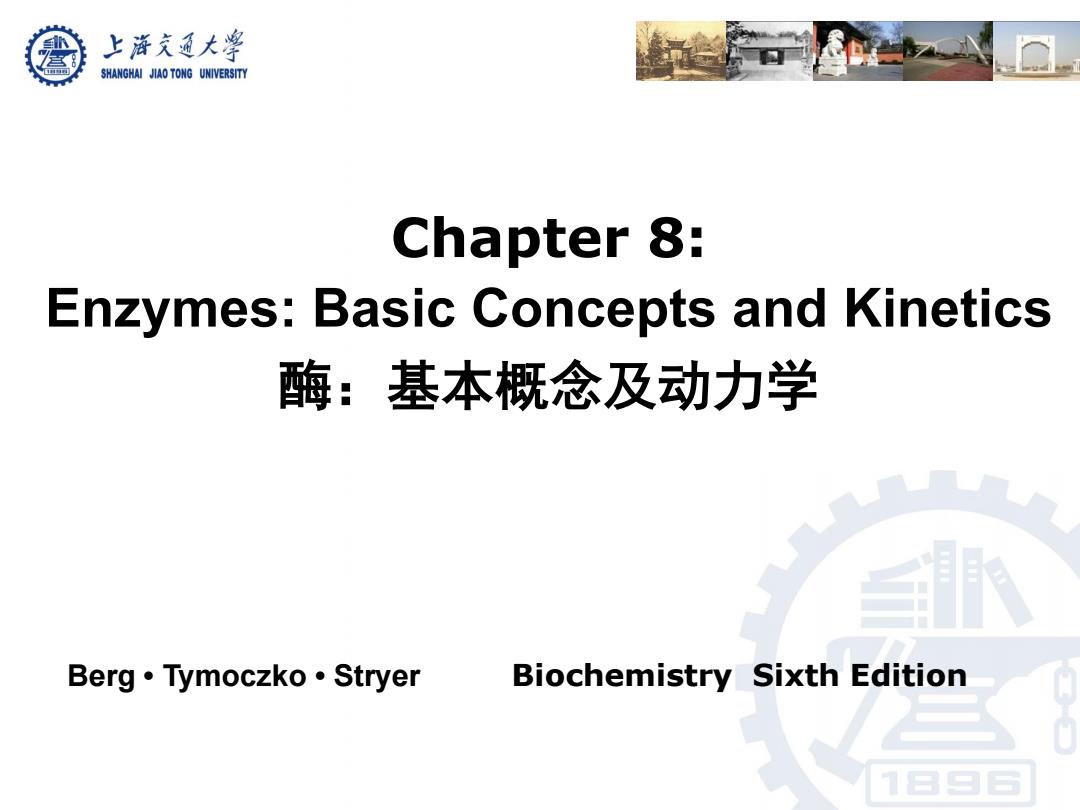
上游充通大兽 SHANGHAI JIAO TONG UNIVERSITY Chapter 8: Enzymes:Basic Concepts and Kinetics 酶:基本概念及动力学 Berg·Tymoczko·Stryer Biochemistry Sixth Edition
Berg • Tymoczko • Stryer Biochemistry Sixth Edition Chapter 8: Enzymes: Basic Concepts and Kinetics 酶:基本概念及动力学
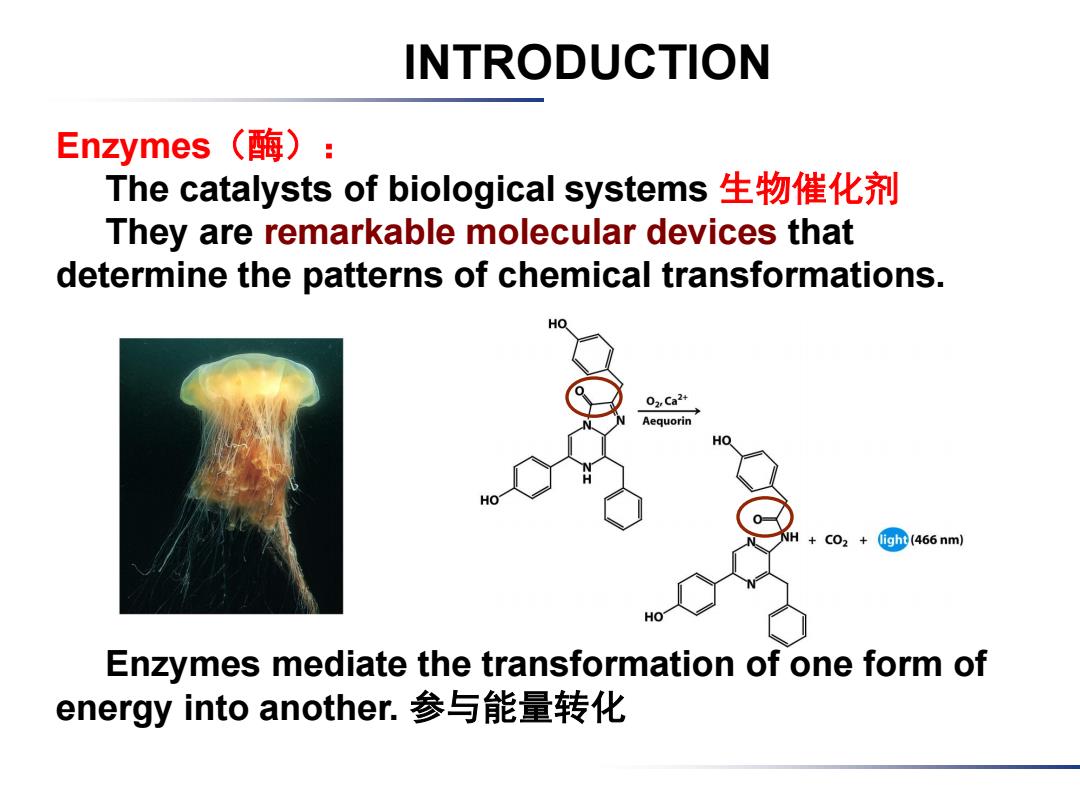
INTRODUCTION Enzymes(酶): The catalysts of biological systems生物催化剂 They are remarkable molecular devices that determine the patterns of chemical transformations. HO 02,Ca24 Aequorin HO NH + CO2 (ig (466 nm) Enzymes mediate the transformation of one form of energy into another.参与能量转化
Enzymes(酶): The catalysts of biological systems 生物催化剂 They are remarkable molecular devices that determine the patterns of chemical transformations. Enzymes mediate the transformation of one form of energy into another. 参与能量转化 INTRODUCTION
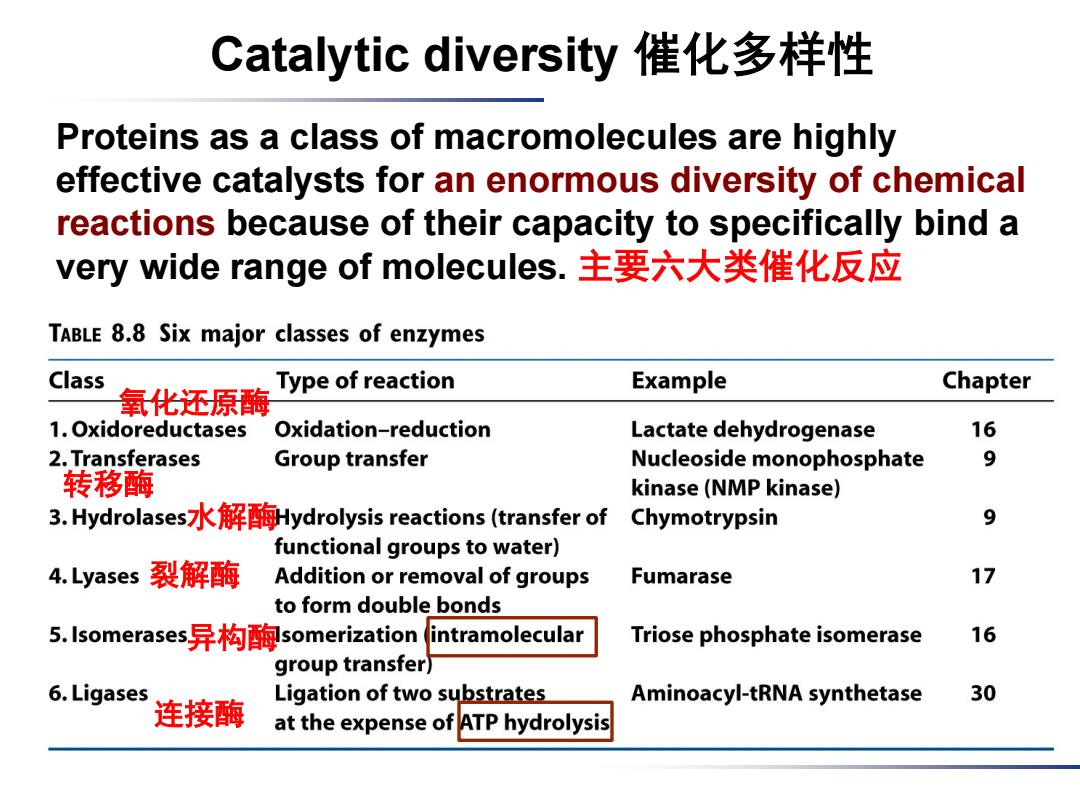
Catalytic diversity催化多样性 Proteins as a class of macromolecules are highly effective catalysts for an enormous diversity of chemical reactions because of their capacity to specifically bind a very wide range of molecules.主要六大类催化反应 TABLE 8.8 Six major classes of enzymes Class Example Chapter 氧化还原酶 Type of reaction 1.Oxidoreductases Oxidation-reduction Lactate dehydrogenase 16 2.Transferases Group transfer Nucleoside monophosphate 9 转移酶 kinase(NMP kinase) 3.Hydrolases:水解酶Hydrolysis reactions(transfer of Chymotrypsin 9 functional groups to water) 4.Lyases 裂解酶 Addition or removal of groups Fumarase 17 to form double bonds 5.Isomerases!异构酶somerization(intramolecular Triose phosphate isomerase 16 group transfer) 6.Ligases Ligation of two substrates Aminoacyl-tRNA synthetase 30 连接酶 at the expense of ATP hydrolysis
Catalytic diversity 催化多样性 Proteins as a class of macromolecules are highly effective catalysts for an enormous diversity of chemical reactions because of their capacity to specifically bind a very wide range of molecules. 主要六大类催化反应 氧化还原酶 转移酶 水解酶 裂解酶 异构酶 连接酶
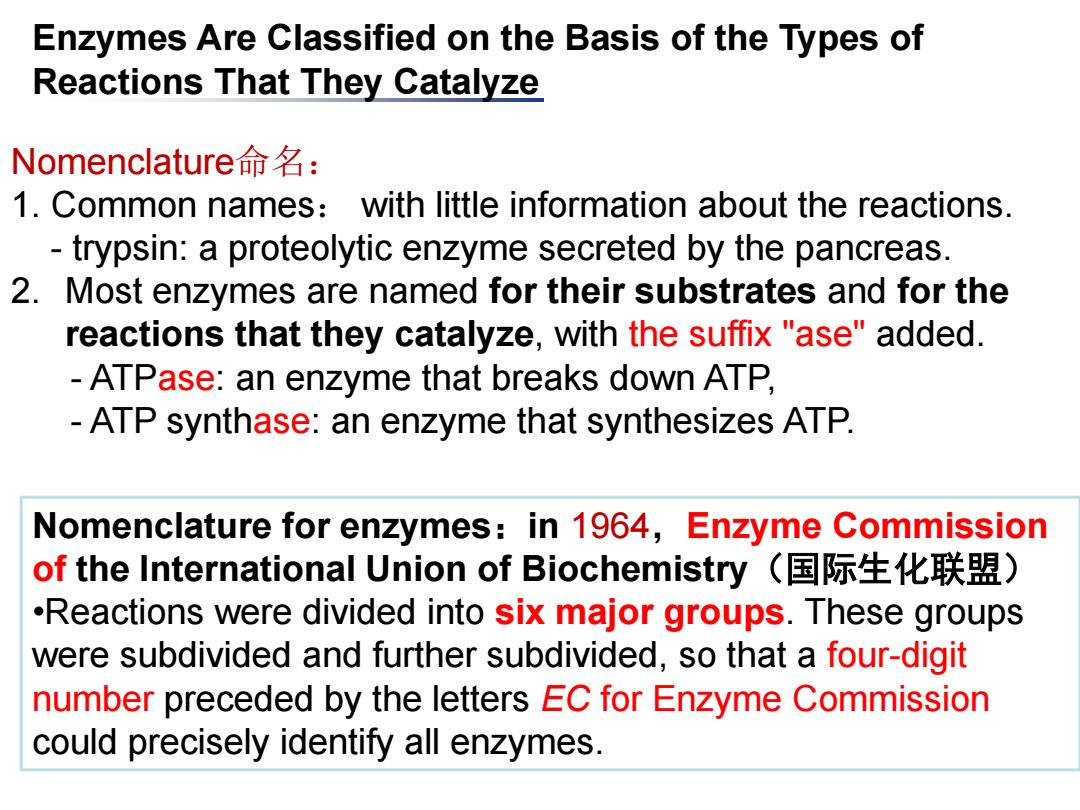
Enzymes Are Classified on the Basis of the Types of Reactions That They Catalyze Nomenclature命名: 1.Common names:with little information about the reactions. trypsin:a proteolytic enzyme secreted by the pancreas. 2.Most enzymes are named for their substrates and for the reactions that they catalyze,with the suffix "ase"added. ATPase:an enzyme that breaks down ATP, ATP synthase:an enzyme that synthesizes ATP. Nomenclature for enzymes:in 1964,Enzyme Commission of the International Union of Biochemistry(国际生化联盟) .Reactions were divided into six major groups.These groups were subdivided and further subdivided,so that a four-digit number preceded by the letters EC for Enzyme Commission could precisely identify all enzymes
Enzymes Are Classified on the Basis of the Types of Reactions That They Catalyze Nomenclature命名: 1. Common names: with little information about the reactions. - trypsin: a proteolytic enzyme secreted by the pancreas. 2. Most enzymes are named for their substrates and for the reactions that they catalyze, with the suffix "ase" added. - ATPase: an enzyme that breaks down ATP, - ATP synthase: an enzyme that synthesizes ATP. Nomenclature for enzymes:in 1964,Enzyme Commission of the International Union of Biochemistry(国际生化联盟) •Reactions were divided into six major groups. These groups were subdivided and further subdivided, so that a four-digit number preceded by the letters EC for Enzyme Commission could precisely identify all enzymes
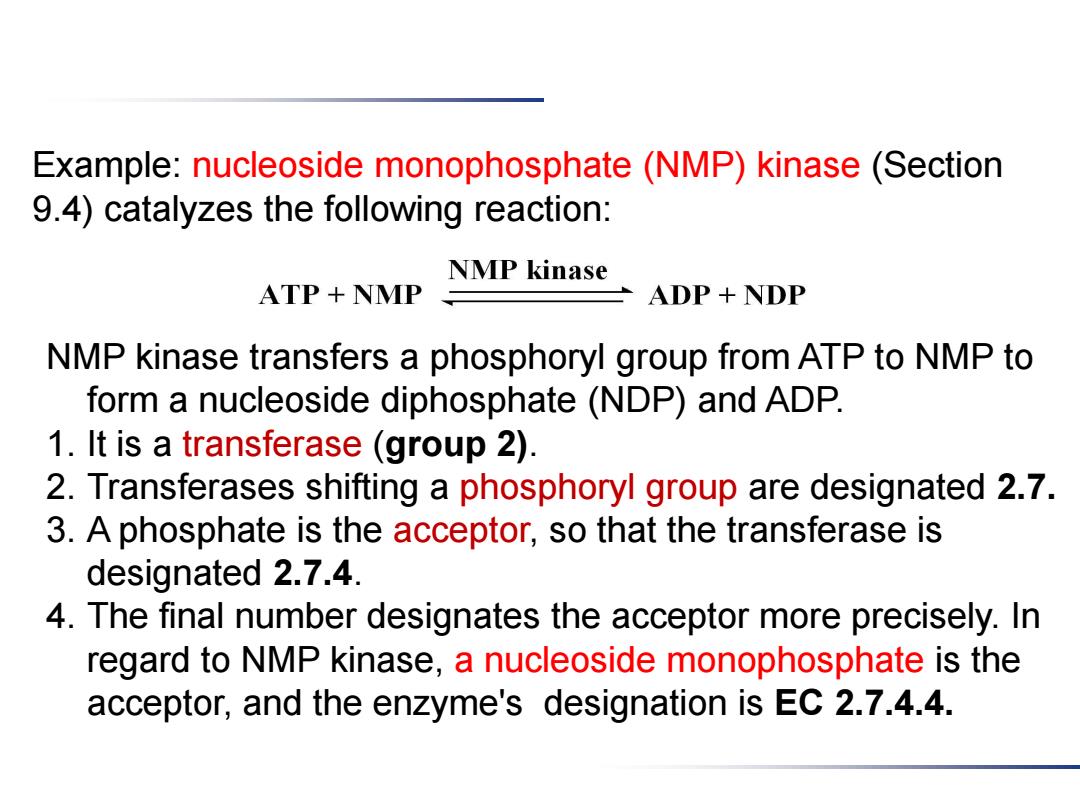
Example:nucleoside monophosphate (NMP)kinase(Section 9.4)catalyzes the following reaction: NMP kinase ATP NMP ADP+NDP NMP kinase transfers a phosphoryl group from ATP to NMP to form a nucleoside diphosphate(NDP)and ADP. 1.It is a transferase (group 2). 2.Transferases shifting a phosphoryl group are designated 2.7. 3.A phosphate is the acceptor,so that the transferase is designated 2.7.4. 4.The final number designates the acceptor more precisely.In regard to NMP kinase,a nucleoside monophosphate is the acceptor,and the enzyme's designation is EC 2.7.4.4
Example: nucleoside monophosphate (NMP) kinase (Section 9.4) catalyzes the following reaction: NMP kinase transfers a phosphoryl group from ATP to NMP to form a nucleoside diphosphate (NDP) and ADP. 1. It is a transferase (group 2). 2. Transferases shifting a phosphoryl group are designated 2.7. 3. A phosphate is the acceptor, so that the transferase is designated 2.7.4. 4. The final number designates the acceptor more precisely. In regard to NMP kinase, a nucleoside monophosphate is the acceptor, and the enzyme's designation is EC 2.7.4.4

The most striking characteristics:特点 一 Catalytic power(催化高效性) Specificity(选择性) Chemical nature: 一Proteins蛋白质(Nearly all known enzymes are proteins,but proteins are not an absolute monopoly on catalysis); Catalytically active RNA molecules a biocatalyst early in evolution (Section 2.2.2)
The most striking characteristics:特点 - Catalytic power (催化高效性) - Specificity (选择性) Chemical nature: - Proteins 蛋白质 (Nearly all known enzymes are proteins, but proteins are not an absolute monopoly on catalysis); - Catalytically active RNA molecules : a biocatalyst early in evolution (Section 2.2.2)
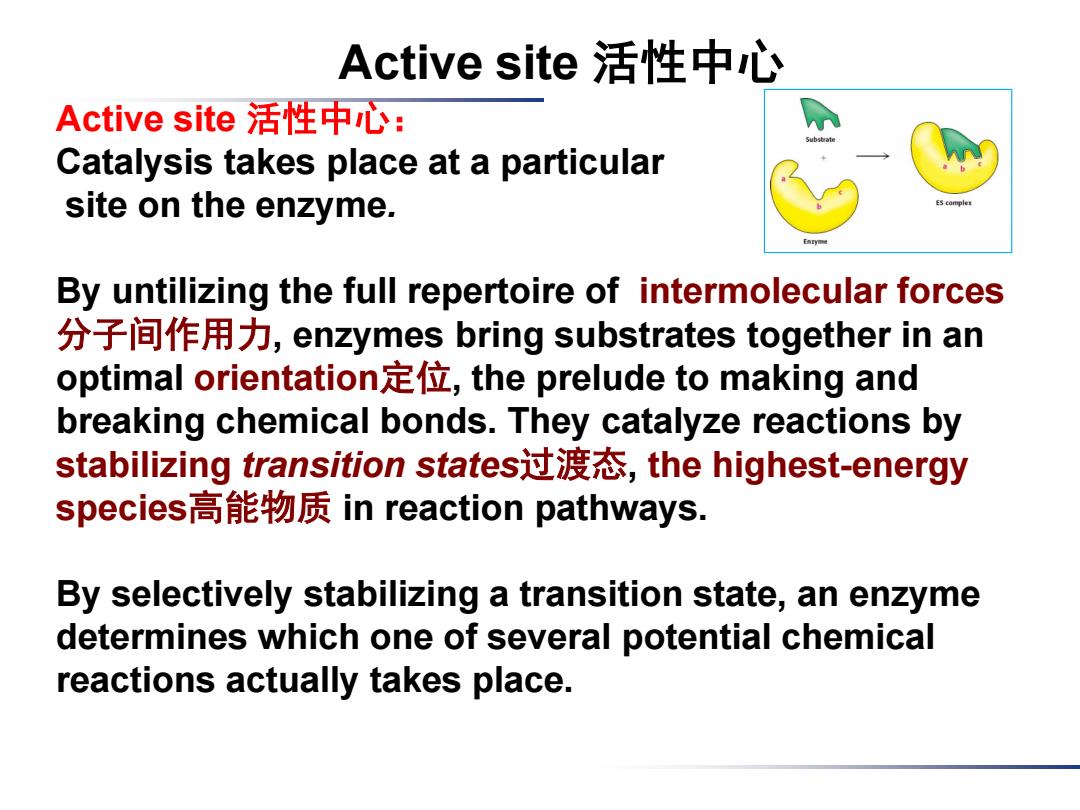
Active site活性中心 Active site活性中心: Catalysis takes place at a particular site on the enzyme. By untilizing the full repertoire of intermolecular forces 分子间作用力,enzymes bring substrates together in an optimal orientation定位,the prelude to making and breaking chemical bonds.They catalyze reactions by stabilizing transition states过渡态,the highest-.energy species高能物质in reaction pathways. By selectively stabilizing a transition state,an enzyme determines which one of several potential chemical reactions actually takes place
Active site 活性中心: Catalysis takes place at a particular site on the enzyme. By untilizing the full repertoire of intermolecular forces 分子间作用力, enzymes bring substrates together in an optimal orientation定位, the prelude to making and breaking chemical bonds. They catalyze reactions by stabilizing transition states过渡态, the highest-energy species高能物质 in reaction pathways. By selectively stabilizing a transition state, an enzyme determines which one of several potential chemical reactions actually takes place. Active site 活性中心
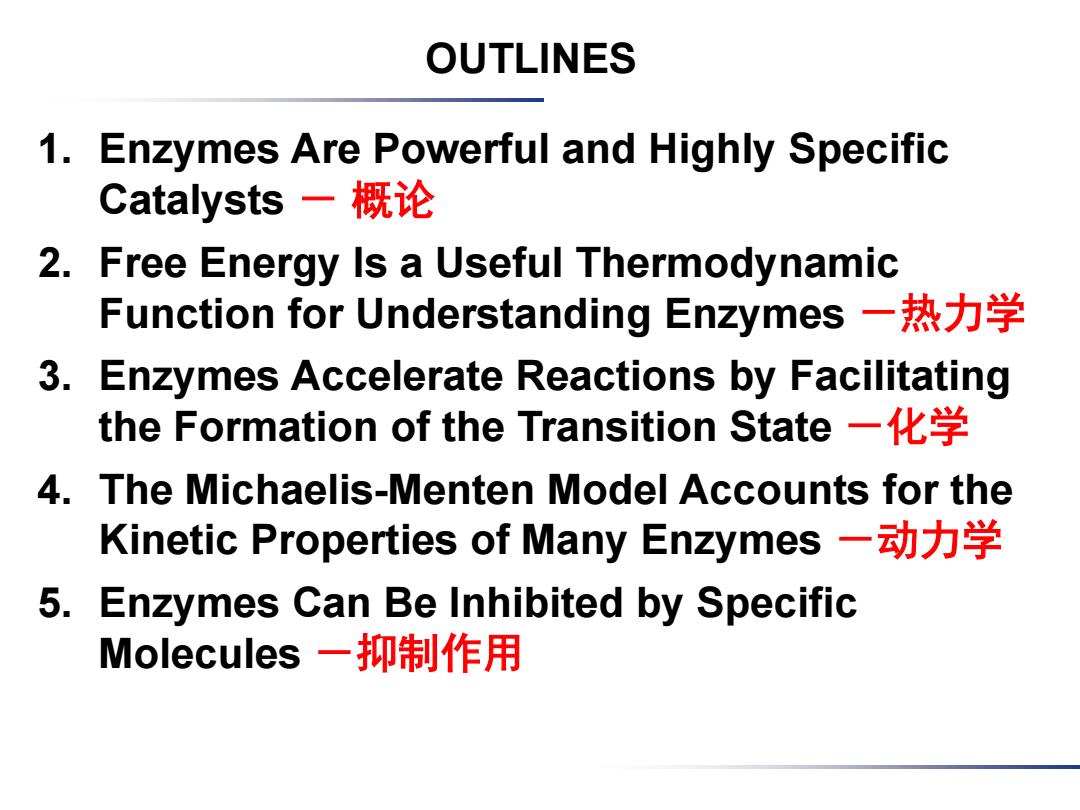
OUTLINES 1.Enzymes Are Powerful and Highly Specific Catalysts一概论 2.Free Energy Is a Useful Thermodynamic Function for Understanding Enzymes一热力学 3.Enzymes Accelerate Reactions by Facilitating the Formation of the Transition State一化学 4. The Michaelis-Menten Model Accounts for the Kinetic Properties of Many Enzymes一动力学 5.Enzymes Can Be Inhibited by Specific Molecules一抑制作用
1. Enzymes Are Powerful and Highly Specific Catalysts - 概论 2. Free Energy Is a Useful Thermodynamic Function for Understanding Enzymes -热力学 3. Enzymes Accelerate Reactions by Facilitating the Formation of the Transition State -化学 4. The Michaelis-Menten Model Accounts for the Kinetic Properties of Many Enzymes -动力学 5. Enzymes Can Be Inhibited by Specific Molecules -抑制作用 OUTLINES
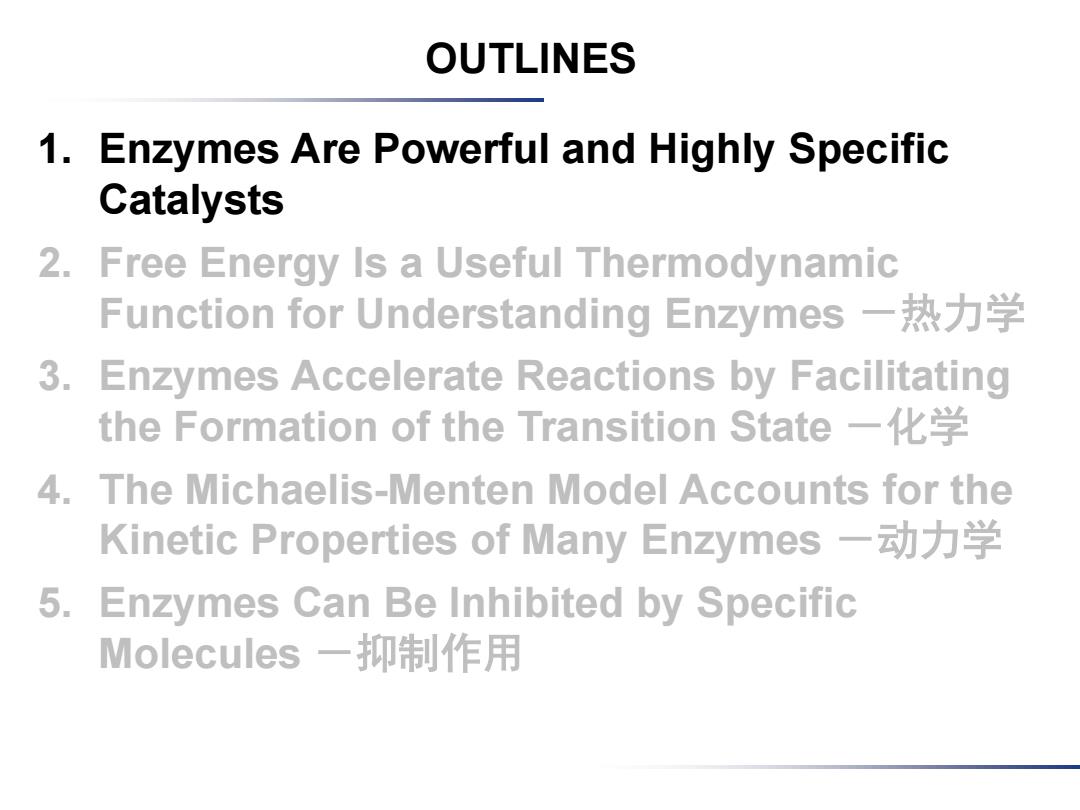
OUTLINES 1.Enzymes Are Powerful and Highly Specific Catalysts 2.Free Energy Is a Useful Thermodynamic Function for Understanding Enzymes一热力学 3. Enzymes Accelerate Reactions by Facilitating the Formation of the Transition State一化学 4.The Michaelis-Menten Model Accounts for the Kinetic Properties of Many Enzymes一动力学 5.Enzymes Can Be Inhibited by Specific Molecules一抑制作用
1. Enzymes Are Powerful and Highly Specific Catalysts 2. Free Energy Is a Useful Thermodynamic Function for Understanding Enzymes -热力学 3. Enzymes Accelerate Reactions by Facilitating the Formation of the Transition State -化学 4. The Michaelis-Menten Model Accounts for the Kinetic Properties of Many Enzymes -动力学 5. Enzymes Can Be Inhibited by Specific Molecules -抑制作用 OUTLINES

Enzymes Are Powerful Enzymes accelerate reactions by factors of as much as a million or more. TABLE 8.I Rate enhancement by selected enzymes Nonenzymatic Uncatalyzed rate Catalyzed rate Rate enhancement Enzyme half-life (kun-) (kat) (kcatS-/kunS-l) OMP decarboxylase 78,000,000 years 2.8X10-16 39 1.4×107 Staphylococcal nuclease 130,000 years 1.7X10-13 95 5.6X1014 AMP nucleosidase 69,000 years 1.0×10-11 60 6.0×1012 Carboxypeptidase A 7.3 years 3.0X109 578 1.9X1011 Ketosteroid isomerase 1 weeks 1.7×10-7 66,000 3.9X101 Triose phosphate isomerase 1.9 days 4.3X106 4,300 1.0X109 Chorismate mutase 7.4 hours 2.6X10-5 50 1.9X105 Carbonic anhydrase 5 seconds 1.3×101 1×105 7.7X105 Abbreviations:OMP,orotidine monophosphate;AMP,adenosine monophosphate. Source:After A.Radzicka and R.Wofenden.Science 267(1995):90-93. Indeed,most reactions in biological systems do not take place at perceptible rates in the absence of enzymes
Enzymes Are Powerful Enzymes accelerate reactions by factors of as much as a million or more. Indeed, most reactions in biological systems do not take place at perceptible rates in the absence of enzymes